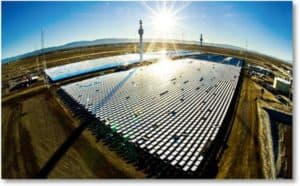Are solar power plants are a true clean energy source? Do they affect water, wind, soil or other elements? Are they applicable in just any sunny region of the world and what is the cost to the environment as, certainly, everything has its footprint?
Climate change is real. In recent years we have witnessed a rapid increase in the levels of energy coming from renewable sources, particularly wind and solar. However, despite offering a great deal of potential as a major future source of zero-carbon energy, concerns exist.
For many of us, solar power means solar panels. Also common as photovoltaic (PV) panels, these are an increasingly common sight on urban rooftops and industrial-scale facilities worldwide. Yet, photovoltaic panels are not the only way we can capture the sun’s energy.
Concentrated Solar Power Plants
One policy question for local and federal decision-makers is whether and how to promote renewable electricity development in the face of competing water demands. A major renewable energy technology in consideration are concentrated solar power (CSP) plants. Yet, are they a viable alternative to PV? CSP produces heat or electricity using hundreds of mirrors to concentrate the sun’s rays to a very high temperature.
The steam turbines at CSP facilities get cooler with water in a process known as wet cooling. Questions arise about the potential cumulative impact of CSP in dry regions about whether, and how to invest in large-scale deployment of CSP. Water demand is very dependent on the location and type of CSP facilities and data for these evolving technologies are preliminary.
The Issue with Water
In dry and semi-dry regions or in other areas with intense water demand, water supply is an issue for locating thermoelectric power plants, not only CSP. The trend is toward more freshwater-efficient cooling technologies for CSP and other thermoelectric generation. CSPs using wet cooling can consume more water per unit of electricity generated than traditional fossil fuel facilities with wet cooling.
Options exist for reducing the freshwater consumed by CSPs and other thermoelectric facilities. Available freshwater-efficient cooling options, however, generally do not eliminate water resource impacts. Often they do not reduce the quantity of electricity produced and increase electricity production costs either.
What will shape the cumulative effect of CSP deployment on water resources and the long-term sustainability of CSP as a renewable energy technology?
- the quantity of electricity produced at these facilities,
- the water intensity per unit of electricity generated, and
- the local and regional constraints on freshwater
Water resource limitations may prompt adoption of more freshwater-efficient technologies or decisions not to site CSPs in certain locations.
Water constraints do not necessarily preclude CSP, given the alternatives available to reduce the freshwater use at CSPs. Moreover, water impacts are one of many factors to consider when judging the tradeoffs between different energy options. Those factors could be cost, climate and air pollution emissions, land and ocean impacts, wildlife and the environmental impacts.
Policies
Countries and states are responsible for most water planning, management, and allocation and electricity sitting decisions. Whether and how the government should promote water conservation, efficiency, markets, and regional- and state-level planning and collaboration is debatable. At the same time, policies (e.g., energy, agriculture, and tax) can affect water-related investments and water use. Operations of facilities can affect the water available for allocation.
Deserts have very little water. Paradoxically, one of the main expected future uses of CSP is for desalination. That turns sea water into water for drinking or irrigation for populations in dry areas. Certainly, further R&D into this application of CSP technology could also help to offset any negative effects on global and local water supplies.
Many developers may think that they will be under less pressure to consider water-use due to the sheer remoteness many sites, but people who live may see it very differently. Involving local communities in making location decisions and in distributing potential rewards is critical.
Credit: Excerpts from Desertec and CRS
Check out our articles on Solar Power Infographic – the Power of Solar Power, LED Bulb – No Brainer, Energy Efficiency Around the World

